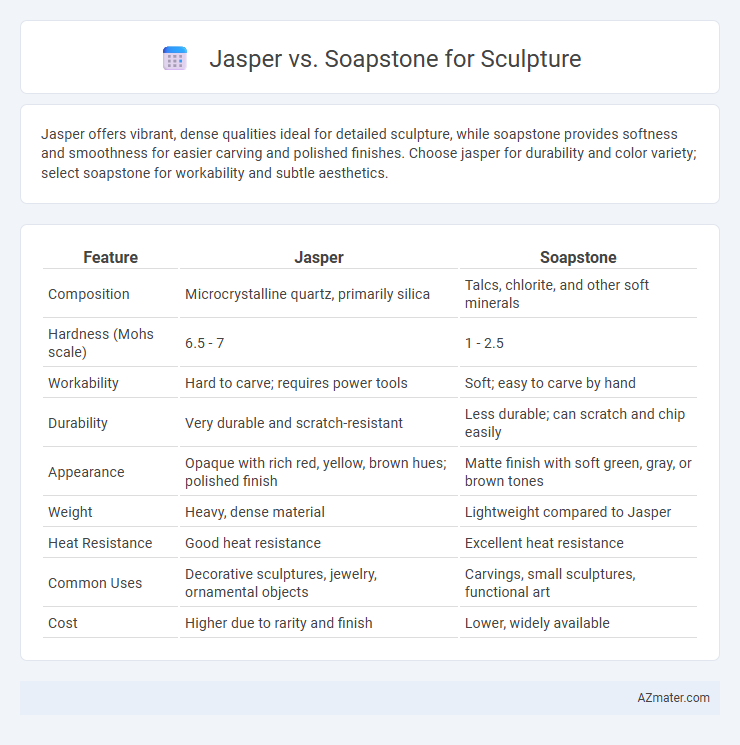Jasper offers vibrant, dense qualities ideal for detailed sculpture, while soapstone provides softness and smoothness for easier carving and polished finishes. Choose jasper for durability and color variety; select soapstone for workability and subtle aesthetics.
Table of Comparison
| Feature | Jasper | Soapstone |
|---|---|---|
| Composition | Microcrystalline quartz, primarily silica | Talcs, chlorite, and other soft minerals |
| Hardness (Mohs scale) | 6.5 - 7 | 1 - 2.5 |
| Workability | Hard to carve; requires power tools | Soft; easy to carve by hand |
| Durability | Very durable and scratch-resistant | Less durable; can scratch and chip easily |
| Appearance | Opaque with rich red, yellow, brown hues; polished finish | Matte finish with soft green, gray, or brown tones |
| Weight | Heavy, dense material | Lightweight compared to Jasper |
| Heat Resistance | Good heat resistance | Excellent heat resistance |
| Common Uses | Decorative sculptures, jewelry, ornamental objects | Carvings, small sculptures, functional art |
| Cost | Higher due to rarity and finish | Lower, widely available |
Introduction to Jasper and Soapstone
Jasper is an opaque, microcrystalline variety of quartz known for its rich, earthy colors and hardness around 6.5 to 7 on the Mohs scale, making it durable yet challenging to carve. Soapstone, primarily composed of talc, is much softer with a Mohs hardness of 1 to 2, allowing intricate detailing and a smooth finish in sculpture. The distinct physical properties of jasper and soapstone influence their suitability for different sculptural techniques and artistic expressions.
Physical Properties Comparison
Jasper is a dense, opaque quartz variety known for its hardness of 6.5 to 7 on the Mohs scale, providing excellent durability and resistance to scratches in sculpture. Soapstone, composed primarily of talc, has a much softer constitution with a Mohs hardness of 1 to 2, allowing easier carving but reducing its overall durability and resistance to impact. The higher heat resistance and finer grain of jasper make it ideal for detailed, long-lasting sculptures, while soapstone's softness offers versatility for intricate, smooth finishes.
Workability and Carving Ease
Jasper is a dense, fine-grained gemstone that offers moderate workability for sculpture but requires sharper tools and more effort due to its hardness, typically around 6.5 to 7 on the Mohs scale. Soapstone, significantly softer at 1 to 2 on the Mohs scale, provides excellent carving ease, making it ideal for detailed and intricate sculptures with minimal tool wear and less physical strain. Artists seeking smooth finishes and quicker shaping often prefer soapstone, whereas jasper is chosen for its durability and polished aesthetic despite being more challenging to carve.
Color and Visual Appeal
Jasper offers vibrant, multicolored patterns ranging from deep reds to earthy greens, providing a dynamic visual appeal that enhances sculptural depth. Soapstone features soft, muted tones like gray, green, and cream, delivering a smooth and subtle aesthetic that highlights carved details. The choice between jasper's rich, variegated hues and soapstone's understated elegance depends on the desired color intensity and textural contrast in sculpture.
Durability and Longevity
Jasper is an extremely durable gemstone with a hardness rating of about 6.5-7 on the Mohs scale, making it highly resistant to scratches and environmental wear, ideal for sculptures meant to last many years. Soapstone, with a lower hardness of 1-2, is much softer and more susceptible to scratches and dents, though it offers excellent workability for detailed carving. For sculptures where durability and longevity are paramount, jasper provides superior resistance to weathering and mechanical damage compared to soapstone.
Cost and Availability
Jasper and soapstone differ significantly in cost and availability for sculpture purposes; jasper is generally more expensive due to its hardness and rarity, making it ideal for detailed, durable sculptures but less accessible. Soapstone is widely available and more affordable, with a softer composition that allows easier carving, making it a popular choice for beginners and budget-conscious artists. The cost-effectiveness and accessibility of soapstone often outweigh jasper when large or multiple sculptures are considered.
Finishing and Polishing Results
Jasper offers a smooth, dense surface that responds well to fine sanding, allowing for a high-gloss polish that enhances its natural vibrant colors and intricate patterns. Soapstone, being softer and more porous, achieves a matte to satin finish with less effort but rarely attains the same mirror-like shine as jasper. Sculptors favor jasper for detailed, polished works requiring a durable, lustrous finish, while soapstone is preferred for tactile, softly polished pieces with subtle textural appeal.
Best Uses for Jasper in Sculpture
Jasper is highly prized in sculpture for its durable, fine-grained texture and vibrant, rich color variations that enhance intricate carvings and detailed artistic works. Its hardness (6.5-7 on the Mohs scale) allows sculptors to create polished, smooth surfaces ideal for both indoor decorative pieces and outdoor monuments. Jasper's natural patterning makes it especially suitable for abstract and figurative sculptures where visual complexity and durability are essential.
Best Uses for Soapstone in Sculpture
Soapstone is ideal for sculpture due to its softness and workability, making it perfect for intricate carvings and fine details. Its smooth texture allows for easy shaping and polishing, which enhances the finished piece's tactile qualities. Best uses include creating detailed figurines, bas-reliefs, and small to medium-sized sculptures where precision and surface finish are paramount.
Choosing the Right Stone for Your Sculpture
Jasper offers vibrant colors and increased hardness, making it ideal for detailed and durable sculptures that require fine polish and longevity. Soapstone, being softer and easier to carve, suits artists seeking to work quickly and create smooth, matte finishes with intricate curves. Selecting between Jasper and Soapstone depends on the desired balance between hardness, color variety, and carving ease for your specific sculptural project.

Infographic: Jasper vs Soapstone for Sculpture
 azmater.com
azmater.com